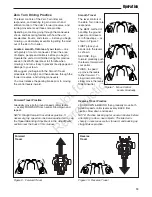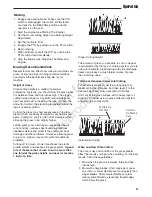
33
Regular Maintenance
Return-to-Neutral Adjustment
To determine if is necessary to adjust the neutral
return, perform the following steps.
1. Disengage the PTO, engage the parking brake
and turn off the engine.
2. Move the ground speed control levers into the
operating position, pull levers rearward and
release.
3. Move the ground speed control levers out towards
the neutral position. If the levers do not align
with the notches in the neutral lock plate, it is
necessary to adjust the neutral return rod (B,
Figure 30).
Adjustment
1. Lock the ground speed control lever in the neutral
position.
2. Measure the length of the neutral return spring
(C, Figure 30) it should be set at 3.25” (8.23 cm).
If the spring does not measure 3.25” (8.23 cm)
loosen the front set collar (D) and rear set collar
(A), then move the front set collar forward or back
on the neutral return rod (B) until the spring length
equals 3.25” (8.23 cm). Retighten the front set
collar.
3. Make sure that the neutral return bushing (E) is
seated correctly in the spring stop plate (F).
4. Position the rear set collar so that it sets tightly
against the neutral return bushing and tighten.
5. Pull the ground speed control lever rearward
and release to check position again. Adjust as
necessary to align the ground speed control levers
with the notches in the neutral lock plate.
It is important to note that after every adjustment
of the neutral return rod, the lever must be pulled
rearward and released to properly check the neutral
position.
Figure 30. Neutral Return Spring Adjustment
A. Rear Set Collar
B. Neutral Return Rod
C. Neutral Return Spring
D. Front Set Collar
E. Neutral Return Bushing
F. Spring Stop Plate
F
C
D
B
E
A
3.25”
8.23 cm
WARNING
To avoid serious injury, perform adjustments
only with engine stopped, key removed and
tractor on level ground.
Not
for
Reproduction
















































